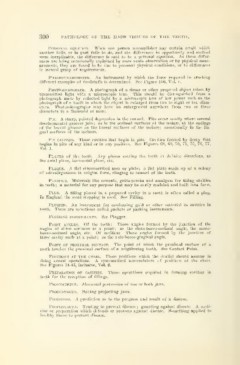Page 558 - My FlipBook
P. 558
300 PATHOLOGY OF THE HARD TISSUES OF THE TEETH.
Peksoxal equation. When one person accomplishes any certain result, which
another fails, or in part fails to do, and the differences in opportunity and method
seem inexplicable, the difference is said to be a personal equation. As these differ-
ences are being occasionally explained by more acute observation or by physical meas-
urements, they are found to be due to personal physical conditions, or to differences
in mental grasp of requirements.
Phagodynamometer. An instrument by which the force required in crushing
different examples of foodstuffs is determined. See Figure 166, Vol. I.
Photomicrograph. A photograph of a tissue or other prepared object taken by
transmitted light with a microscopic lens. This should be distinguished from a
photograph made by reflected light by a microscopic lens of low power such as the
photograph of a tooth in which the object is enlarged from two to eight or ten diam-
eters. Photomicrographs may have an enlargement anywhere from two or three
diameters to a thousand or more.
Pit. a sharp, pointed depression in the enamel. Pits occur mostly where several
developmental grooves join; as in the occlusal surfaces of the molars, at the endings
of the buccal grooves on the buccal surfaces of the molars; occasionally in the lin-
gual surfaces of the incisors.
Pit cavities. Those cavities that begin in pits. Cavities formed by decay that
begins in pits of anj' kind or in any position. See Figures 68, 69, 70, 71, 75, 76, 77,
Vol. 1.
Planes of the teeth. Any planes cutting the teeth in definite directions, as
the axial plane, horizontal plane, etc.
Plaque. A flat circumscribed area or plate ; a flat plate made up of a colony
of microorganisms in zooglea form, clinging to enamel of the teeth.
Plastics. Materials like cements, gutta-percha and amalgam for filling cavities
in teeth; a material for any purpose that may be easily modeled and built into form.
Plug. A filling placed in a prepared cavity in a tooth is often called a plug.
In England the word stopping is used. See Pilling.
Plugger. An instrument for condensing gold or other material in ca\'ities in
teeth. These are sometimes called packers or packing instruments.
Plugging instruments. See Plugger.
Point angles. Of the teeth: Those angles formed by the junction of the
angles of three surfaces at a point; as the disto-bucco-occlusal angle, the mesio-
bucco-occlusal angle, etc. Of cavities: Those angles formed by the junction of
three cavity walls at a point; as the axio-bucco-gingival angle.
Point of proximal contact. The point at which the proximal surface of a
tooth touches the proximal surface of a neighboring tooth. See Contact Point.
Positions at the chair. Those positions which the dentist should assume in
doing dental operations. A systematized nomenclature of positions at the chair.
See Figures 34-45, inclusive, Vol. 2.
Preparation op cavities. Those operations required in forming cavities in
teeth for the reception of fillings.
Prognathism. Abnormal protrusion of one or both jaws.
Prognathous. Having projecting jaws.
Prognosis. A prediction as to the progress and result of a disease.
Prophylactic. Tending to prevent disease; guarding against disease. A medi-
cine or preparation which defends or protects against disease. Something applied to
healthy tissue to prevent disease.


